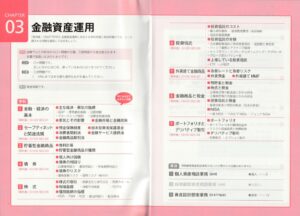管理人オススメコンテンツはこちら
「勉強すれば必ず報われる|試験の不安をゼロに!FP3級合格への完全ロードマップ」
〜前回のつづき〜
●試験の概要
(1)FPの試験範囲
試験範囲は次の6分野です。
1-a)ライフプランニングと資金計画

(出典:みんなが欲しかった!FPの問題集3級 以後同じ)
主に3大資金計画
・住宅
・教育
・老後
それから公的な社会保険
・医療保険
・介護保険
・年金保険料
について学ぶ。
1-b)リスクマネジメント

ここで私的な保険について
理解を深めていく訳です。
・生命保険
・損害保険
・自動車保険
・障害保険
など幅広い範囲を学びます。
1-c)金融資産運用

・株式
・債券
・投資信託
このような
金融商品について学習します。
1-d)タックスプランニング

ここで税金ですね。
・所得税
・法人税
・消費税
などの税金について学びます。
1-e)不動産

・賃貸や売買
・税金
・有効活用
について学習します。
1-f)相続・事業承継

・相続税
・贈与税
を主に学びます。
ザッと項目を見ると
わかると思いますけど
お金の基礎教養を
体系的に学べる唯一の資格です。
(2)試験概要
試験実施団体は
・きんざい(一般社団法人 金融財政事情研究会)
の2つがあり
きんざいは
主に金融機関の人が受けいて
レベルとしては
ちょっと難しい印象です。
FP協会のほうが
一般の人が受験しています。
なのでFP協会の方について
お話しします。
試験要項
↓
https://www.jafp.or.jp/exam/app/howto/files/outline_3fp.pdf
FP3級の基礎データを見てみると
・受験者数
→年間14万人前後
・試験
→CBT(Computer Based Testing)試験
最寄りの会場を予約して
随時受験する事が出来ます。
CBTS受験者専用サイト
↓
https://cbt-s.com/examinee/examination/jafp_3
・合格率
学科:7〜8割
実技:8〜9割
・受験料

(出典:https://cbt-s.com/examinee/examination/jafp_3)
学科と実技が分かれてますが
試験範囲は一緒です。
学科試験は◯✕式と3択
実技は事例形式で3択です。
FP資格を勉強した人に
「勉強して良かったか?」
と聞くと口を揃えて
「いい勉強になった!!」
と言っています。
そんなに取るのも難しくないし
その割に必要な知識が体系的に学べて
すごくいい資格だと思います。
●勉強方法
メチャクチャシンプルです。
予備校とか行く必要は有りません。
一切不要です。
独学でやりましょう。
これで十分合格出来ます。
(1)市販のテキスト
(2)問題集
を揃えて
テキストを見ながら
問題集を2〜3周やる。
以上です。
FP試験は結構試験の傾向が安定してるし
難問・奇問がほとんど無いんですよ。
この手の資格を取ろうとすると
たまに何年かに一回
すごい難問・奇問が出る時が
有るんですよ。
「これ受かる人いるの?」
みたいな。
ことFP3級に関しては
そういうのがあまり有りません。
勉強すれば必ず報われるという試験です。
私が使っているのは
TAC出版 滝沢ななみ著
『みんなが欲しかった』シリーズです。
これをやれば合格レベルに到達出来ます。


この2冊をやり込むだけで
100%合格します。
他の副教材は本当にいらないです。
これであれば
お金もそんなにかからないです。
クセの無い教材なので
・合う
・合わない
という問題も無いのではないでしょうか?
Amazon1位を取るぐらい
人気教材なので
安心して使えます。
結構分厚くて
扱いが結構大変なので

テキストと問題集
それぞれ6分野ごとに
切り分けて使っています。

問題集に関しては
コンビニで拡大コピーして
製本してノートのようにして
使っています。
ポイントを書き込む事が出来るし
文字も大きいので読みやすい。
なんだか頭にも
よく入ってくる気がします。
●その他参考サイト
ご興味があれば見てみてください。
・ほんださん / 東大式FPチャンネル
・なかちの解説チャンネル
・1級FPたぬぽんのFP講座【たぬ吉資格塾】
・TAC出版
〜〜〜つづく〜〜〜
Special Thanks college president Ryo.
●おまけ
≪≪Chat-GPTくんによる要約→perplexityちゃんによる文章まとめ≫≫
FP3級試験の概要と勉強法についてまとめます。
FP3級の試験範囲は、ライフプランニングと資金計画、リスクマネジメント、金融資産運用、タックスプランニング、不動産、相続・事業承継の6分野です。試験は「きんざい」とFP協会が実施しており、一般向けにはFP協会が主流です。年間受験者数は約14万人で、試験はCBT(Computer Based Testing)形式で行われます。合格率は学科で7〜8割、実技で8〜9割と比較的高いです。
勉強方法は独学が推奨されており、市販のテキストと問題集を使うことで十分に合格可能です。特におすすめなのが、TAC出版の『みんなが欲しかった!FPの教科書3級』と『問題集3級』です。この2冊を繰り返し学習することで、合格レベルに到達できます。問題集は拡大コピーして製本し、ノート形式で使うと効率的です。FP3級は難問が少なく、体系的な金融知識を学べる貴重な資格です。
Citations:
[1] https://www.foresight.jp/fp/column/studytime/
[2] https://www.agaroot.jp/fp/column/level3-self-study/
[3] https://www.u-can.co.jp/course/data/in_html/50/column/column42.html
[4] https://moalicense.jp/fp/houhou.htm
[5] https://www.tac-school.co.jp/kouza_fp/fp_sk_idx/contents_3q_dokugaku.html
[6] https://shikakupass.com/column/category-fp2/1256/
[7] https://www.agaroot.jp/fp/column/level2-study-method/
[8] https://money-study.net/fp/exam/2nd.htm
≪≪Chat-GPTくんによる英訳≫≫
Continuing from the previous discussion,
here is an overview of the FP Level 3 exam and its study methods.
The FP exam covers six areas. The first is Life Planning and Financial Planning, where you study the three major financial plans: housing, education, and retirement. Additionally, you learn about public social insurance systems, including health insurance, long-term care insurance, and pension premiums. The second area, Risk Management, focuses on private insurance such as life, property, auto, and disability insurance, offering a broad range of topics. The third area, Financial Asset Management, deals with financial instruments like stocks, bonds, and investment trusts. In the fourth area, Tax Planning, you study different types of taxes, including income tax, corporate tax, and consumption tax. The fifth area, Real Estate, covers topics like renting, selling, taxation, and effective utilization. The final area, Inheritance and Business Succession, mainly focuses on inheritance tax and gift tax. This qualification is unique in that it allows you to systematically learn the basics of money.
The exam is administered by two organizations: Kinzei (The Financial and Fiscal Affairs Research Association) and the Japan FP Association. Kinzei’s exam is considered slightly more difficult and is primarily taken by those in the financial industry. The Japan FP Association’s exam is more popular among general candidates and will be the focus of this explanation.
The FP Level 3 exam is taken by approximately 140,000 people annually. It uses a computer-based testing format, allowing candidates to book a nearby venue and take the test at their convenience. The pass rates are 70–80% for the academic section and 80–90% for the practical section. Both sections cover the same content, with the academic part featuring true/false and multiple-choice questions, and the practical part using case-based multiple-choice questions. Most people who study FP agree that it is a highly rewarding qualification. It is not overly difficult, and it provides a systematic way to learn essential financial knowledge.
Studying for the FP exam is simple and does not require attending prep schools or extra courses. Independent study with the right materials is sufficient. The recommended materials are a textbook and a workbook. By working through these materials two or three times, you can effectively prepare for the exam. The exam’s content is consistent, and there are no surprising or overly tricky questions, making it a fair test where effort is rewarded.
I personally recommend the “Everyone Wanted!” series by Nanami Takizawa, published by TAC. This series includes a textbook and workbook for FP Level 3 and is reliable, widely used, and reasonably priced. The content is straightforward and does not have any quirks that could make it unsuitable for certain learners. The materials are quite thick, so dividing them by the six subject areas can make them easier to handle.
For the workbook, enlarging and copying the pages at a convenience store and binding them into a notebook format can be helpful. This allows you to write directly on the pages, and the larger text makes them easier to read. Many find that this approach improves their retention of the material. By following this method, you can prepare efficiently and effectively for the FP Level 3 exam.
Special Thanks OpenAI and Perplexity AI, Inc


